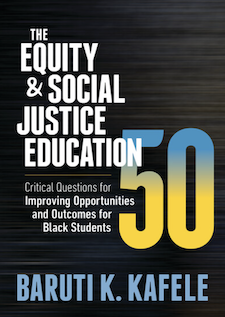Improving Opportunities & Outcomes for Black Kids
The Equity & Social Justice Education 50: Critical Questions for Improving Opportunities and Outcomes for Black Students
By Baruti K. Kafele
(ASCD, 2021 – Learn more)
Reviewed by Claire Stein

Personally, I have been reflecting on my own experiences, understanding and place in the world for many years, and I appreciated the way Baruti Kafele lays out his work to push thinking and attitudes.

Although it is vital to review data and ask critical questions about how we are getting the results we are getting, it is equally important to reflect on our own biases and how those are influencing our practices intentionally or unintentionally.
My central questions
The question prompts all give the reader opportunities to really reflect. There were a few that stood out to me. “Do all my students have an equitable opportunity to learn and grow in my classroom?” Kafele suggests asking this question at the start each day, throughout the day, and at the end of the day to really move from reflection to self-adjustment.
“Am I an equity mindset teacher?” The author not only defines an equity mindset teacher, he reminds the reader that equity work is not something to move to; it has to be natural. It has to be something that practitioners do naturally through their understanding and compassion for their students.
Lastly, “What is the evidence that your presence positively alters the trajectory of each of your students?” Kafele drills deeper into this with questions that get at the evidence that your Black students feel they belong and are on a trajectory for success as a result of you being in your classroom. This really hits at the heart of the book: not only are my black students on a trajectory of success but also are they on this path due to my presence as their teacher.
Real reflection, hard conversations and uncomfortable feelings are all part of the change process, and our data tells us we need to change. Making these things personal is the only way to effectively move through change and get our students the belonging, success, and equitable experience they need and deserve.
Social justice contrasts with racial justice
The final chapter, “Social Justice Education and Racial Justice Education: Are They the Same?”, really hit home. Social justice education and racial justice education are both important but are not the same. If injustices are a result of the color of someone’s skin, it is a racial justice issue. Ignoring this difference or race altogether is a mistake and diminishes individual experience.
Kafele reminds us that the time for politely avoiding intense conversations around race is over. His motto, If it impacts the students, we must be willing to discuss it, really summed up a lot of what his book covers and what equity and social justice work is all about. We cannot continue with business as usual and think we will have better outcomes.
We cannot continue to look at our students, colleagues and families and not see that we are different and bring various perspectives, experiences and needs to our schools. As the author states, “Each student is somebody. Each student is somebody special.” And equity is teachers navigating the differences in what students bring to the classroom.
A call to action
Kafele opens and closes his book with the reminder that he was compelled to write the book in an effort to change the education landscape which finds Black students on the wrong side of the achievement gap and discipline along with other negative gaps reflecting inequity in the system.
Kafele’s compulsion results in a book that is not just another book providing ways to reflect on equity and professional practices. It is a call to action. The author prompts the reader to continuously ask, “Who am I when I am in my classroom with my Black students?”
Claire Stein is a former middle school teacher in Southern Wisconsin. She currently works in an administrative role in her school district. Claire is passionate about creating joyful learning spaces for all students and seeking out strategies to utilize in her own work and share with colleagues and other educators.

































